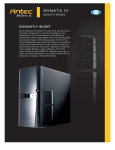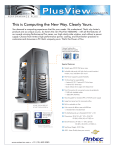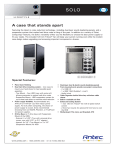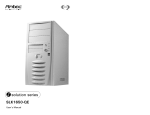Download Antec Plus View II User's Manual
Transcript
User’s Manual Manuel de l’utilisateur Anwenderhandbuch Manuale per l’operatore Manual del usuario At Antec, we continually refine and improve our products to ensure the highest quality. So it's possible that your new case may differ slightly from the descriptions in this manual. This isn't a problem; it's simply an improvement. As of the date of publication, all features, descriptions, and illustrations in this manual are correct. Disclaimer This manual is intended only as a guide for Antec's Computer Enclosures. For more comprehensive instructions on installing your motherboard and peripherals, please refer to the user's manuals which come with your components and drives. PLUSVIEW II SOHO SERVER CASE WITH CLEAR SIDE WINDOW This case comes with a clear side window. There is an 80mm fan mount with vents on the window to cool the hottest graphics cards on the market. Your new case comes without a power supply. We recommend installing Antec's TruePower 2.0 or NEO 480 power supply for best performance. SETTING UP 1. Place the case upright on a flat, stable surface. The 120mm exhaust fan should be at the back, facing you. 2. Remove the thumb-screws from the right side panel. Unlatch the panel and remove it by swinging it out. Note: Don't use your fingernail to pry or lift the panels. 3. Inside the case you should see some wiring with marked connectors (USB, PWR etc.), an installed I/O panel, a tool box containing more hardware (screws, brass standoffs, plastic stands, etc.), and eight drive rails. INSTALLING THE POWER SUPPLY 1. With the case upright, place the power supply on the support beam that runs from the 5.25" drive bays to the back of the case. Note: most dual-fan power supplies should be installed with the second fan towards the bottom of the case. 2. Push the power supply to the back of the case and align the mounting holes. 3. Attach the power supply to the case, with the screws provided. INSTALLING THE MOTHERBOARD This manual does not cover CPU, RAM, or expansion card installation. Please consult your motherboard manual for specific mounting instructions and troubleshooting. 1. Lay the case down, with the open side facing up. The drive cages and power supply should be visible. 2. Make sure you have the correct I/O panel for your motherboard. If the panel provided with the case isn't suitable, please contact your motherboard manufacturer for the correct I/O panel. 3. Line up your motherboard with the standoff holes, and remember which holes are lined up. Not all motherboards will match with all the provided holes; this is normal, and won't affect functionality (in other words, there will likely be extra holes). 4. Remove your motherboard by lifting it up. 5. Screw the brass standoffs into the threaded holes that line up with your motherboard. Do not overtighten the standoffs. Some standoffs may be pre-installed for your convenience. 6. Place your motherboard on the brass standoffs. 7. Screw in your motherboard to the standoffs with the provided Philips-head screws. Your motherboard is now installed. 2 CONNECTING THE POWER AND LED 1. Connect the 24-pin or 20-pin ATX power connector and +12V 4-pin connector to your motherboard. Note: an ATX12V v2.0 power supply comes with a 24-pin power connector. This is the latest Intel form factor power supply. 2. Connect the Reset switch (labeled RESET SW) to your motherboard at the RST connector. Make sure the label always faces the front of the case. 3. Power LED (labeled POWER LED) connector is located behind the Reset connector. 4. Power Switch (labeled POWER SW) connects to the PWR connector on the motherboard. 5. Speaker (labeled SPEAKER) connector is behind the PWR connector. 6. Hard Drive LED (labeled HDD) connects to the IDE connector. 7. LED I, LED II connectors: This case comes with two extra LEDs, marked I, II. You may use these LED for various purposes such as SC SI LED, Message LED, etc. CONNECTING THE USB PORTS You will find a single 10-pin connector on a cable attached to the front USB ports. This is an Intel standard connector, which is keyed so that it can't be accidently reversed as long as it is connected to a proper Intel standard motherboard header. Connect the 10-pin connector to your motherboard headers so that the blocked pin fits over the missing header pin. Note: Please check your motherboard manual for your USB header pin layout and make sure it matches the attached table. If it does not match this Intel standard, please call Antec customer service at (800) 22ANTEC (North America) or +31 (0) 10 462-2060 (Europe) to buy a USB adapter. This adapter will allow you to connect the front USB to your motherboard on a pin-by-pin basis. 1 9 2 Motherboard Pin Layout Pin Signal Names Pin Signal Names 1 USB Power 1 2 USB Power 2 3 Negative Signal 1 4 Negative Signal 2 5 Positive Signal 1 6 Positive Signal 2 7 Ground 1 8 Ground 2 9 Key (No Pin) 10 Empty Pin 10 CONNECTING THE IEEE 1394 (FIREWIRE®, I.LINK®) PORT You will find a single 10-pin connector on a cable attached to the front IEEE 1394 connection. This is an Intel standard connector which is keyed so that it can't be accidentally reversed as long as it is connected to a proper Intel standard motherboard header. Connect the 10-pin connector to your motherboard header so that the blocked pin fits over the missing header pin. Note: Please check your motherboard manual for your IEEE 1394 header pin layout and make sure it matches the attached table. If you intend to connect the front FireWire port to an IEEE 1394 add-on card that comes with an external-type IEEE 1394 connector, please call Antec customer service at (800) 22ANTEC (North America) or +31 (0) 10 462-2060 (Europe) to buy an adapter. This adapter will allow you to connect the front IEEE 1394 port to the external-type connector. 3 1 9 2 Motherboard Pin Layout for Front Panel IEEE 1394 Connector Pin Signal Names Pin Signal Names 1 TPA+ 2 TPA– 3 Ground 4 Ground 5 TPB+ 6 TPB– 7 +12V (Fused) 8 +12V (Fused) 9 Key (No Pin) 10 Ground 10 CONNECTING THE AUDIO PORTS There is an Intel standard 10-pin connector (with 7 individual wires with connectors) coming out from the front panel speaker and microphone connection If your motherboard supports Intel's standard onboard audio connector, you can plug in the 10-pin connector directly onto the board. For non-Intel standard audio connection, you need to plug the 7 individual connectors to the motherboard. See instructions below: Locate the internal audio connectors from your motherboard or sound card. Consult your motherboard or sound card manual for the pin-out positions. 1. 2. 3. 4. 5. 6. 7. Microphone Signal Pin: Connect the MIC connector to this pin. Microphone Power: Connect the MIC-BIAS connector to this pin. Ground Pin: Connect the GND connector to this pin. Front Right Speaker Out Pin: Connect the FPOUT-R connector to this pin. Front Left Speaker Out Pin: Connect to the FPOUT-L connector to this pin. Rear Right Speaker Out Pin: Connect to the RET-R connector to this pin. Rear Left Speaker Out Pin: Connect the RET-L connector to this pin. Note: Your motherboard may not support rear speaker output. In this case, you do not need to connect RET-R and RET-L. 3.5" DEVICE INSTALLATION With the front bezel facing you, swing the plastic door out. It can open 270 degrees to rest against the side of the case. You can see there are four 5.25" and two 3.5" external drive bays. Inside the case there are two 3.5" drive cages that house six 3.5" drive bays of which two are for external 3.5" devices and four are for internal 3.5" devices. 1. Pull the quick release lever towards the rear of the case and release the top cage first. Looking from the rear of the case you can see some metal grills over the exposed (external) drive bays. Carefully put a screwdriver through the metal grill and gently push the plastic drive bay cover until it comes off. Carefully use your hands to twist the metal plate back and forth until it breaks off. Note: Don't remove the covers and plates for the drive bays that you are not using now. Be careful of the newly exposed metal where the grills were attached, as these areas are likely to be sharp. 2. Install your floppy drive into the top 3.5" drive bay. 3. Mount your other 3.5" device into the drive cage. 4. Slide and lock the drive cage back into the case. 5. Release the second cage. Note: Inside the cage you will find a fan bracket. If you want to have a cooling fan in the drive cage, you should install the fan before installing the drives. For fan installation please see the Fan installation section of this manual. 4 6. Mount your other 3.5" devices into the drive cage. 7. Slide and lock the drive cage back into the case. 8. Find the proper connector on the power supply (SATA, floppy, or standard 4-pin) and connect it to the male connector on your device. 5.25" DEVICE INSTALLATION 1. Take off the plastic drive bay covers and metal plates as described above. 2. Take two of the drive rails and mount them to the sides of the 5.25" device. Make sure the metal portion is angled away from the device and facing forward. 3. Slide the device into the drive bay until you hear the rails click. 4. Mount the other devices accordingly. Connect the proper connector (SATA or standard 4-pin) from the power supply to the male connector on the device. THE COOLING SYSTEM The TriCool Fan The case includes one 120mm Blue LED TriCool fan installed in the rear. This fan comes with a three-speed switch that lets you balance quiet performance with maximum cooling (See specifications below). The fan is installed so that the air is blowing out of the case. Connect a large 4-pin connector from the power supply to the male 4-pin connector on the fan. Note: The minimum voltage to start the fan is 5V. We recommend setting the fan speed to High if you choose to connect the fan to a fan control device or to the Fan-Only connector from an Antec TruePower supply. A fan control device regulates fan speed by varying the voltage to it, and the voltage may start as low as 4.5 V to 5V. Setting the TriCool speed to Medium or Low and connecting it to a fan control device may result in the fan not being able to start as the already low voltage from the fan control device will be further reduced by the TriCool circuitry to lower than 5V. Specifications Size: Rated Voltage: Operating Voltage: 120 x 120 x 25.4 mm DC 12V 10.2V~13.8V Speed Input Current Air Flow Static Pressure Acoustical Noise Input Power High 2000 RPM 0.24A (Max.) 2.24 m³/min. (79 CFM) 2.54 mm-H2O (0.10 inch-H2O) 30 dBA 2.88 W Medium 1600 RPM 0.2A 1.59m³/min. (56 CFM) 1.53 mm-H2O (0.06 inch-H2O) 28 dBA 2.4 W Low 1200 RPM 0.13A 1.1 m³/min. (39 CFM) 0.92 mm-H2O (0.04 inch-H2O) 25 dBA 1.56 W This case comes with two 80mm front fan mounts and one 80mm side fan mount should you choose to install additional cooling fans. Front 80mm fan mounts There are two plastic fan cages. One of them is located inside the 3.5" drive cage to cool your hard drives directly. You should install this fan before you mount your HDD drives into the cage. Install both front-mounted fans by dropping the fan to the cage and pushing it in until it snaps in place. These fans must be installed so that the air is blowing into the case. We recommend using Antec 80mm TriCool fans to balance quiet performance with maximum cooling. (See our website for more product information.) Note: Please choose your fan speed wisely. In most cases, a medium or even low speed setting will be enough to supply adequate cooling. 5 VGA Card Cooling There is an 80mm fan mount with vents on the clear side window right above the VGA card. The vents can supply fresh air to the card without a fan (passive cooling), or with a fan (active cooling) if you are using a high performance VGA card that needs extra cooling. Install the fan so that the air is blowing into the case. We recommend using an Antec 80mm TriCool fan. Maintaining the Washable Air Filter From time to time it will be necessary to wash the installed air filter. Not washing the air filter will result in higher system temperatures and possible stability problems. We recommend checking the air filter at least once a month initially. The frequency will change depending on system usage (users whose systems run 24/7 will likely have to check/wash more often than those who don't use their systems every day) and on environmental conditions. 6 Antec, Inc. 47900 Fremont Blvd. Fremont, CA 94538 Tel: 510-770-1200 Fax: 510-770-1288 Antec Europe B.V. Sydneystraat 33 3047 BP Rotterdam The Netherlands Tel: +31 (0) 10 462-2060 Fax: +31 (0) 10 437-1752 Technical Support US & Canada 1-800-22ANTEC [email protected] Europe +31 (0) 10 462-2060 [email protected] www.antec.com © Copyright 2005 Antec, Inc. All rights reserved. All trademarks are the property of their respective owners. Reproduction in whole or in part without written permission is prohibited. Printed in China. Version 1.0.1 6/01/2005

























